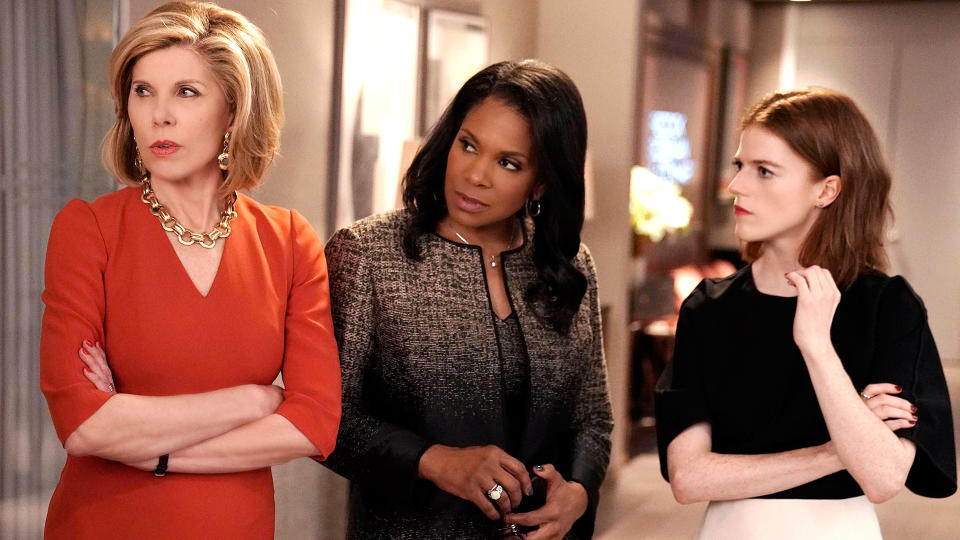How The Good Fight found clarity in chaos, and answers in absurdity

The Good Fight’s title sequence is instructive. Set to a frantic score by David Buckley, it marries ordered elegance with violent disruption; a vase of flowers, phones, a gavel and so on all explode, their pieces scattered. A vibrant red claret from a shattering wine glass fills the screen, and dust and ash float across a dark background.
What it is, in effect, is a means to set the stage. It establishes chaos as the status quo. And then it begs the question: what next?
Where last year The Good Fight heralded a need to fight, it now turns to a different question: how can you fight? Again, the title sequence is instructive, having been fine tuned since last year; the television screens, added to the explosive line-up this season, juxtapose the absurdity of Putin’s overly macho image with the chilling horror of Charlottesville marchers. It’s a world where the awful and the absurd are so often the same; it’s a world ripped from the headlines, after all. As Diane Lockhart (The Good Fight’s inimitable lead, Christine Baranski) notes, “I used to laugh at the absurdity of the news. Now I’m all laughed out”.
Said absurdity is a creeping, pervasive force, as much a representation of chaos as the title sequence; it’s less fake news and more can’t-quite-tell-it-it’s-fake-news, each week seemingly taking us a step closer to The Good Fight’s world where Trump keeps a pot-bellied pig in the White House map room. It’s absurd, yes, but there’s a veneer of… not plausibility, exactly, but possibility; it’s unnerving and unsettling, a disquieting undercurrent at the edge of the narrative that can’t be ignored. Certainly, Diane never could – to her, the absurdity of it all became an obsession, an ever-increasing fixation she couldn’t tear herself away from. At the same time, it was tied to the threat represented by the serial ‘Kill all Lawyers’ murders, another aspect of the eschatological chaos that causing her world to spin away; both symptoms of a world turned on its head, where all its rules are broken.

When you think about it, of course this is such an all-encompassing problem for Diane, because it confronts her own foundational mythology; when all the rules are broken and order turns to disorder, what’s a lawyer meant to do? The chaos and absurdity that have come to define The Good Fight is a problem uniquely suited to Reddick, Boseman and Lockhart.
The show flirts with different answers to this – in one case literally, as Diane starts an affair with an antifa activist Tully Nelson (played by Tim Matheson, a nice piece of meta-casting contrasting him with Diane’s husband Kurt, played by Matheson’s former West Wing co-star Gary Cole). The Good Fight places a rare degree of conviction in Tully’s revolutionary politics; where many other shows would have set him up simply to knock him down again, an example of ideology gone too far, or even just comic relief, but instead there’s a willingness to treat him seriously. Indeed, not just seriously, but seductively – the idea of taking to the streets and overturning the system makes a new sort of sense. Why try and play by the rules when don’t matter anymore?
It’s the same idea, or the same basic principle, that Liz Reddick (Audra MacDonald, a brilliant addition to season 2) puts forward in the seventh episode, a particularly standout instalment, when the Democratic National Committee approaches Reddick/Boseman about impeaching Trump. “Don’t back down, don’t apologise, stay on the offence – these are the new rules”, she says. It’s the new way to fight the good fight, to respond and engage and keep up.
The final scene of The Good Fight’s second season is a direct response to the end of its first. Last year, The Good Fight declared it took place not in “a country of men and women, [but] a country of laws”; this year, after the chaos and the absurdity of it all, the question instead was “what does it matter if we’re a country of laws, if the laws aren’t just?”
And so there’s a new sort of clarity to be found, cutting through the chaos and the absurdity. If the law – if the rules that define the world – offends your conscience, then “it’s okay to break the law”. That’s how you find clarity in chaos, and answers in absurdity: with a bold, confident elegance, and captivating panache.
All words, of course, that you could easily use to describe The Good Fight.
Related:
Like this article? Hate this article? Why not follow me on twitter for more, or send me a message on facebook to tell me what you thought? You can also find more of my articles for Yahoo here, or check out my blog here.

 Yahoo Movies
Yahoo Movies 

